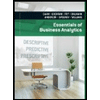
1.
Introduction: If-then hypothesis statements are built to establish the causes and effect relationships between the performance measures in the balanced scorecards. These help in determining whether the performance measures in the balanced scorecards contribute to the strategic goals of the company or not.
To connect the if then hypothesis statements and to indicate whether it should be increased or decreased.
Introduction: The balanced scorecard continuously tests the theories built following the strategic goals of the company. If the strategies are not working as expected, it should be the result of the failure of some if-then hypothesis statements. In such cases, timely changes must be made to the statements to achieve the strategic goals.
The reason for non-improvement in the then statements even if the improvements are made in the if statement.
Want to see the full answer?
Check out a sample textbook solution
Chapter 12 Solutions
MANAGERIAL ACCOUNTING F/MGRS.
- Hh1.arrow_forwardI need typing clear urjent no chatgpt used i will give 5 upvotes pls full explainarrow_forwardYour manager would like you to conduct sensitivity analysis to see how changing both the price and unit cost of a product affect profits. The following data is provided to you. Which of the following actions needs to be completed before building a data table? 26 27 Price 28 Demand 29 Unit cost 30 Fixed cost 31 Revenue 32 Variable cost 33 Profit B с 50.00 28,000.0 12.00 D E Copied Cells 50.0 62,000.0 1,400,000.0=C28 C27 336,000.0=C28 C29 1,798,000.0 SUM(C31,C32.C30) Select one: The incorrect cells have been 'copied' and this will result in a 12.0arrow_forward
- 9. Assuming the management chooses the first option, which amount the product lines will be eliminated?a. La-Lisab. Jenniec. Jisood. Rose_____ 10. Assuming the management chooses to discontinue the unprofitable product line, what is the net impact to the Company’s overall profit?a. P 7,000b. P 17,000c. P 13,000d. P 23,000arrow_forwardQuestions 1. How reliable is your Sales Forecast? Explain your answer. 2. What are some ways you could potentially improve the accuracy of your forecast?arrow_forward4. Which segment has the best margin?a. Segment Ab. Segment Bc. Segment Cd. Segment A and C 5. Which segment has the best sales turnover?a. Segment Ab. Segment Bc. Segment Cd. Segment A and B 6. Which segment has the best ROI?a. Segment Ab. Segment Bc. Segment Cd. Segment A and C 7. What is the ROI for segment A? Enter your number with four decimal points. For example, 5.23% enter as 0.0523:arrow_forward
- QUESTION 6 Let A be a matrix with 5 rows and 2 columns. Which of the following operations are illegitimate? 1. t(A) %*% t(A) 2. A %*% t(A) 3. A %*% A 4. A * A 5. t(A) %*% A 6. nrow(A)*Aarrow_forwardplease fix my excel worksheet and answer this questions as well please as soon as possible: In addition possibly answer this too if possible: c-2. If your recommendation in part (c-1) is followed, what would be the company’s overall profit?arrow_forwardWe can get a sense of how model output responds to changes in inputs from sensitivity analyses. Some argue that we might draw very different conclusions when using different boundaries, especially when model output is a non-linear function of inputs. For example, we compute the net present value (NPV) of a business with a 10% discount rate. We can choose +/- 1% for our sensitivity analysis, or +/-5% for our analysis. For this reason, some argue that one can manipulate sensitivity analysis to support one’s prior. What do you think of this comment?arrow_forward
- pls answer thankyouarrow_forwardEnabled: Chapter 5 What-If Analysis for Linear . 0 Saved Based on the following sensitivity analysis, which of the following products would be considered most sensitive to changes or errors in the objective function coefficient? Variable Cells Final Allowable Allowable Objective Coefficient Cell Name Value Reduced Cost Increase Decrease $B$2 13 4. Product_1 Product_2 Product_3 -2 25 $B$3 175 25 14 11 $B$4 -1.5 25 13 7 Constraints Final Shadow Constraint Allowable Allowable Cell Name Value Price R.H.Side Increase Decrease $H$9 Resource A 100 1E+30 100 $H$10 Resource B 525 800 1E+30 275 SH$11 Resource C 700 1.75 700 366.6666667 700 O Product 3 O Product 2 O Product 1arrow_forwardFast solve plzarrow_forward
 Essentials of Business Analytics (MindTap Course ...StatisticsISBN:9781305627734Author:Jeffrey D. Camm, James J. Cochran, Michael J. Fry, Jeffrey W. Ohlmann, David R. AndersonPublisher:Cengage Learning
Essentials of Business Analytics (MindTap Course ...StatisticsISBN:9781305627734Author:Jeffrey D. Camm, James J. Cochran, Michael J. Fry, Jeffrey W. Ohlmann, David R. AndersonPublisher:Cengage Learning Essentials Of Business AnalyticsStatisticsISBN:9781285187273Author:Camm, Jeff.Publisher:Cengage Learning,
Essentials Of Business AnalyticsStatisticsISBN:9781285187273Author:Camm, Jeff.Publisher:Cengage Learning, Fundamentals of Financial Management, Concise Edi...FinanceISBN:9781305635937Author:Eugene F. Brigham, Joel F. HoustonPublisher:Cengage Learning
Fundamentals of Financial Management, Concise Edi...FinanceISBN:9781305635937Author:Eugene F. Brigham, Joel F. HoustonPublisher:Cengage Learning Fundamentals Of Financial Management, Concise Edi...FinanceISBN:9781337902571Author:Eugene F. Brigham, Joel F. HoustonPublisher:Cengage Learning
Fundamentals Of Financial Management, Concise Edi...FinanceISBN:9781337902571Author:Eugene F. Brigham, Joel F. HoustonPublisher:Cengage Learning Fundamentals of Financial Management, Concise Edi...FinanceISBN:9781285065137Author:Eugene F. Brigham, Joel F. HoustonPublisher:Cengage Learning
Fundamentals of Financial Management, Concise Edi...FinanceISBN:9781285065137Author:Eugene F. Brigham, Joel F. HoustonPublisher:Cengage Learning




